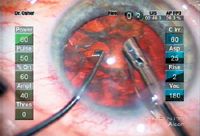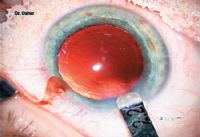Article
Coaxial microphaco
Lisbon, Portugal—Coaxial microphacoemulsification is a new cataract surgery technique that can be readily learned by any ophthalmologist skilled in phacoemulsification in order to afford patients the combined benefits of ultra-small-incision surgery and conventional foldable IOLs, said Robert H. Osher, MD, at the XXIII Congress of the European Society for Cataract and Refractive Surgeons.

The coaxial microphacoemulsification procedure is performed through a 2.2-mm incision and has been made possible by the availability of a new ultrasound sleeve (Ultra Sleeve) used with the Infiniti system and the Infiniti flare tip (Alcon Laboratories).
The new small-diameter sleeve permits surgery using normal flow rates and vacuum levels to enable chamber maintenance and protect against thermal and mechanical injury while allowing efficient emulsification of the nuclear material, said Dr. Osher, professor of ophthalmology, University of Cincinnati College of Medicine, and medical director emeritus, Cincinnati Eye Institute, Cincinnati.

Through rigorously designed, carefully controlled laboratory studies, Dr. Osher initially established that the coaxial microphacoemulsification procedure was associated with superior fluidics compared with surgery performed using bimanual microincision surgery irrigating choppers. Bolstered by the favorable results of those experimental studies, Dr. Osher began performing the coaxial microphacoemulsification procedure on his cataract surgery patients. He will give a presentation at the American Academy of Ophthalmology meeting in Chicago this month.
His clinical experience, which includes more than 100 patients to date, confirms that the innovative technique can be performed safely and efficiently to remove cataracts of all grades. He is able to achieve high rates of excellent uncorrected visual acuity (UCVA) and corneal clarity on the first postoperative day, matching the outcomes seen after conventional coaxial phacoemulsification.

The laboratory studies he conducted compared coaxial phacoemulsification performed with the Ultra Sleeve versus bimanual surgery using 19-, 20-, and 21-gauge irrigating choppers. The results showed the coaxial microphacoemulsification technique was associated with infusion flow rates that were about 60% greater and incision temperatures that were about 20% lower when all other parameters were held constant. Incision competency was also superior with the coaxial technique, as leakage measurements performed over 1 minute with a fixed bottle height demonstrated sevenfold less incision leakage from the 2.2-mm incision. In addition, surge testing in identical silicone chambers demonstrated that coaxial microphacoemulsification using the Ultra Sleeve afforded much less surge and greater chamber stability than the bare-tip bimanual technique.
Newsletter
Don’t miss out—get Ophthalmology Times updates on the latest clinical advancements and expert interviews, straight to your inbox.




